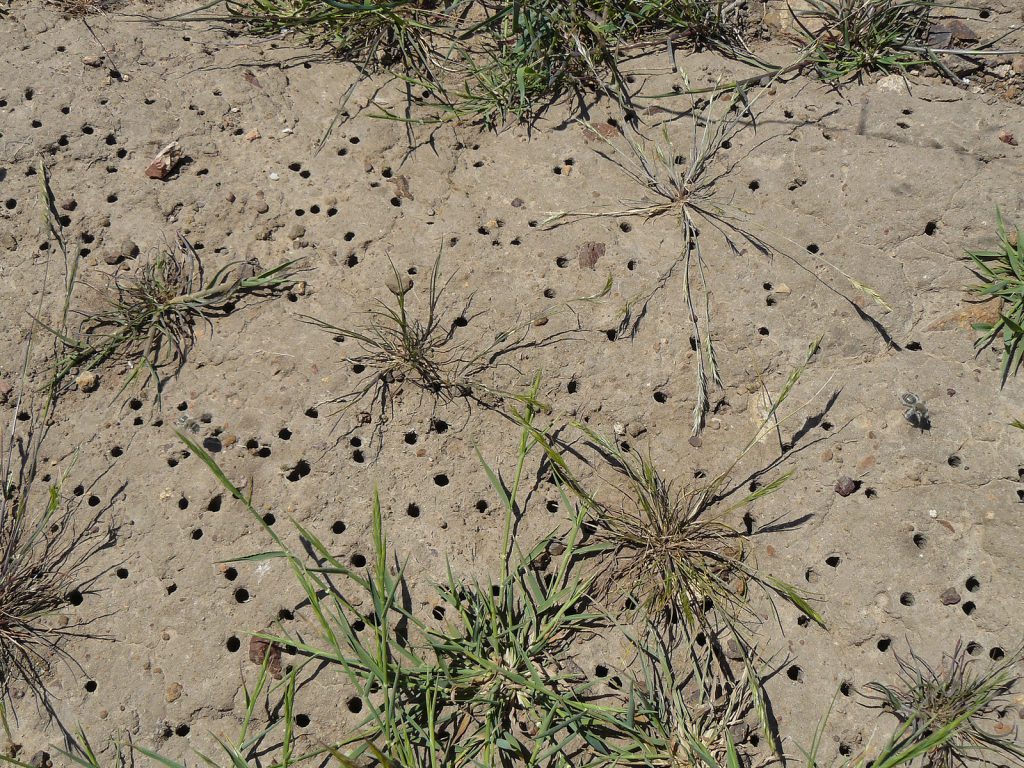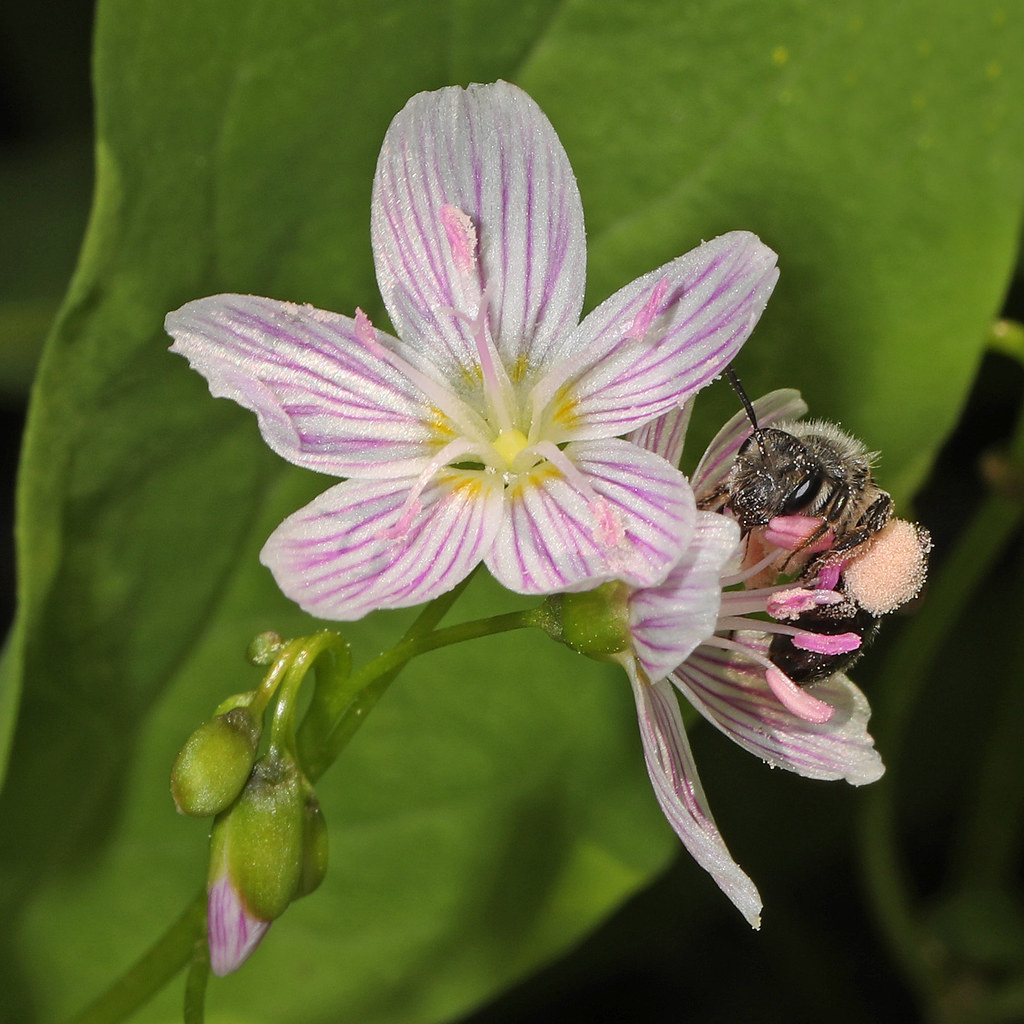Maryland Native Wildlife: Mining Bees
With spring underway, many species are emerging from their winter rest, including our local bees. By far, the most well known bee is the non-native European honey bee (Apis mellifera). However, Maryland is home to over 430 species of bees, many of which are native and all of which provide important roles in pollination.
Often, native bees, which have coevolved with native plants, are extremely effective at pollination. For example, a female Southeastern Blueberry Bee (Habropoda laboriosa) can visit up to 50,000 blueberry flowers in her lifetime, resulting in almost 6,000 blueberries!
Many times, bees are mistaken for their wasp cousins. However, there are several distinguishing characteristics between the two groups. Barring a few exceptions, most bees are hairy and females often have special structures designed for carrying pollen. These structures are either a pollen basket (corbicula) or a patch of stiff hairs (scopa) on each hind leg or under the abdomen. Wasps, on the other hand, generally lack hairs and pollen carrying structures.
All in the Family
Six families of bees have been identified in Maryland. The largest family of bees is the Andrenidae family, which is also known as the mining bees. Most mining bees are active early in the spring and are important pollinators of spring-blooming plants.
As you may have guessed, bees in the Andrenidae family nest in the ground. Andrenids are solitary nesters, but they will group in areas with good habitat. They can be distinguished from social, ground nesting wasps, like yellow jackets, by the multiple holes they create in the ground. Each hole belongs to a different Andrenid female. In contrast, yellow jackets often have one main entrance that serves as a super highway for multiple wasps.
Andrenids rarely sting and are relatively docile. They are mostly dark, black, or reddish, but they can also be metallic blue, yellow, or red and yellow. Many Andrenid bees have velvety patches (foveae) on their faces between the eyes and the base of the antennae. These patches sometimes resemble unruly eyebrows on the bees.
Andrenid bees help pollinate many flowers. Some species, like the spring beauty bee, (Andrena erigeniae) almost exclusively feed on spring beauty, creating a special relationship between the plant and the pollinator. Other plants pollinated by Andrenid bees include apples, blueberries, huckleberries, maples, violets, willows, sunflowers and the like.
Pollinators in Peril
Unfortunately, despite their many benefits, Maryland’s native bees and other pollinators are in decline. Below are some simple ways to help Maryland’s bees:
- Go Native! Native plants have co-evolved with native pollinators. For maximum diversity you should plant a bee buffet that offers nectar and pollen throughout the year. Some excellent choices for bees include black willow (Salix nigra), Canada serviceberry (Amelanchier canadensis), golden Alexanders (Zizia aurea), high bush blueberry (Vaccinium corymbosum), wild columbine (Aquilegia canadensis), sweet pepperbush (Clethra alnifolia), swamp milkweed (Asclepias incarnata), early goldenrod (Solidago juncea), and culver’s root (Veronicastrum virginicum).
- Limit Pesticides. Pesticides are often harmful to non-target critter species like bees and butterflies. By limiting or eliminating pesticide use in your backyard you too can help the bees!
- Maintain Habitat. Did you know that many native bees nest in open, sandy soils? Or that some bees use dead trees? Open, sandy soil, brush piles, old stumps, and dead flower stalks all can be important nursery habitat for nesting bees. Consider leaving these elements in your backyard to entice future bees. You can also supplement these sites by building bee houses.
- Support Research. There is still a lot to learn about our pollinators. You can help by supporting bee research initiatives and participating in citizen science projects. One project to note is Bumble Bee Watch, a collaborative effort to track and conserve North America’s bumble bees. You can take pictures of local bumble bees and upload them to the Bumblebee Watch website.
Happy Spring HabiChat fans!
I hope this newsletter finds you and your loved ones happy and healthy. While this certainly is a trying time, we can make the most of quarantine by connecting with our backyard habitats and the residents they support. I have been enjoying the sounds and signs of spring, including watching an amorous mourning dove woo a potential mate. So far, his attempts seem to be successful!
While many local native plant sales have been canceled, vendors have been working to provide plants via online means. Check out the Maryland Native Plant Society website for a list of local vendors. This time is also a great one to tackle some of the invasive plants that may have found their way into your yard. Check out the Plant Invaders of Mid-Atlantic Natural Areas for information on common invaders and how to properly remove them. I, for one, have been tackling quite a bit of periwinkle (Vinca minor) on the weekends.
In this edition of Habichat, I have created articles on our native mining bees which are active early in the spring, the lovely maple-leaved viburnum, backyard birding tips, and how to create backyard habitat while sheltering in place. In addition to HabiChat, I have also included activities to do with children at home on our wildlife education page.
As spring continues, young wildlife are going to venture out from their dens and nests. It’s important to remember that wildlife don’t have the same parenting procedures as we do, and they often ‘free range’ their young. Check out our page on Think Twice Before Rescuing Young Wildlife to learn about normal behaviors of young animals.
Happy Habitats,
Kerry Wixted
Click here to have HabiChat—the quarterly backyard wildlife habitat newsletter from the Wild Acres program—delivered right to your inbox!
In this Issue
Habitat Tips: Creating Backyard Wildlife Habitat While Sheltering in Place
Native Animal Profile: Mining Bees
Native Plant Profile: Maple-leaved Viburnum
Backyard Birding Tips





 1-888-373-7888
1-888-373-7888 233733
233733